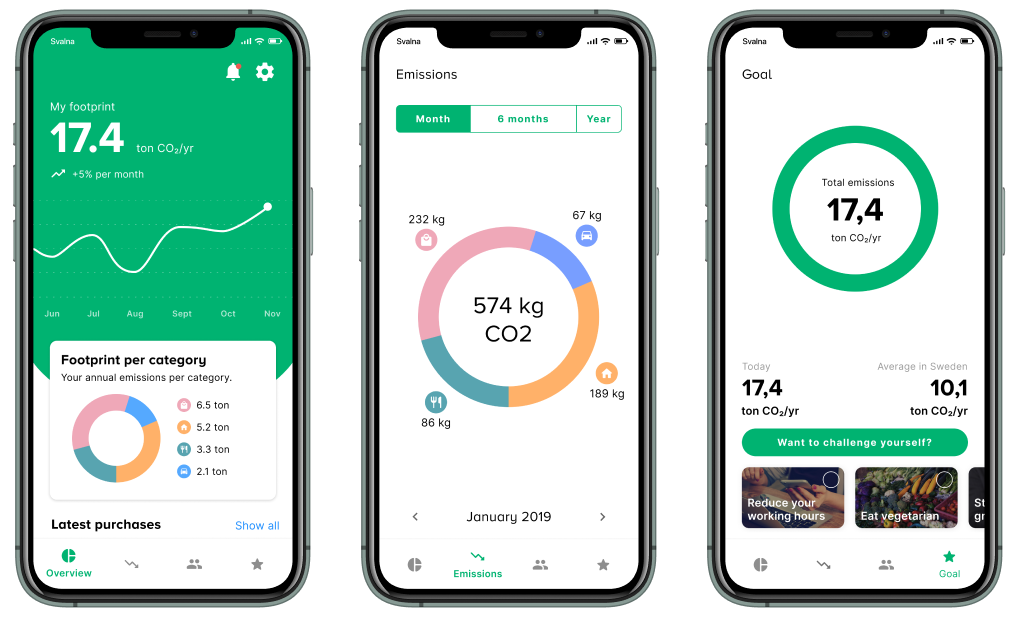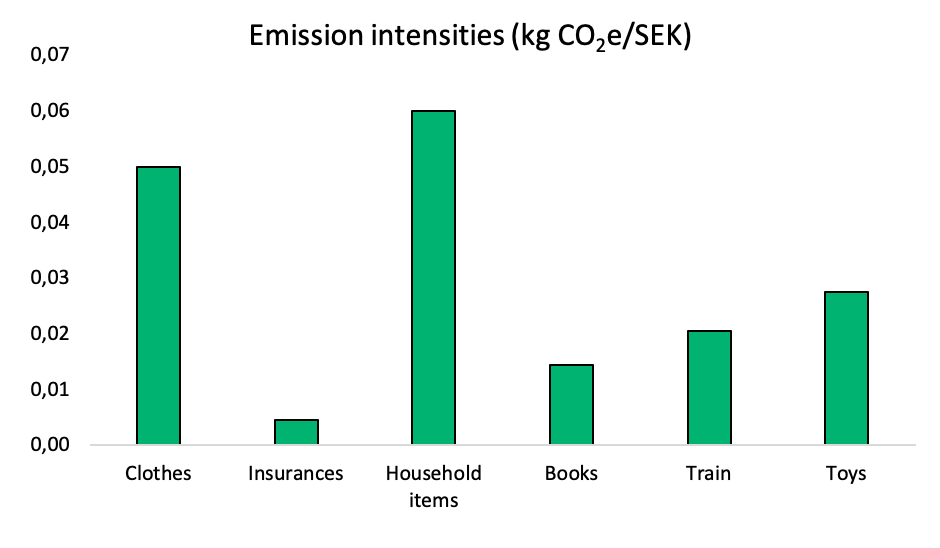
Swedish start-up Svalna leads the way towards better carbon footprint assessments for companies and individuals
We all know that emissions need to be cut — but how, and where do we start? Carbon calculators can be powerful tools for estimating the greenhouse gas emissions of individuals as well as enterprises — an important first step towards lowering the emissions.
Svalna — a world leader in sophisticated carbon footprint assessments
The Swedish start-up Svalna has developed a unique method that uses financial transaction data for calculating the greenhouse gas emissions of individuals and organizations. In 2019, Svalna launched an app that is now used by approximately 16,000 private Swedish consumers. The app calculates the user’s carbon footprint based on financial transaction data from the user’s bank, in combination with data from official registers, and data entered by the user.

Screenshots from the Svalna app
In 2019, Svalna also started developing a methodology for calculating the carbon footprints of companies and organizations, based on the same basic principle. Svalna is currently the only company in the world that offers a largely automatic and scientifically-based approach for estimating the carbon footprints of individuals, companies and organizations based on financial transaction data.
“We want to help our clients get a better overview of their emissions, so they can take appropriate measures to reduce their emissions and achieve set targets”
- David Andersson, CEO and founder of Svalna.
Financial data finds novel use in climate assessments
The novelty of Svalna’s solutions lies in the use of financial data: transaction data from the user’s bank in the case of private individuals, and data from the financial accounting system for companies and organizations. Private consumers who use Svalna’s app can connect their bank accounts and credit cards to the tool, thereby enabling Svalna to estimate the greenhouse gas emissions from spendings within different consumption categories such as clothes, furniture, public transport, etc. Transaction data are available for between three months and five years back in time, depending on the bank. That means users can see how their carbon footprint has changed over time already at the first login.
All data communication is encrypted, and data are stored on secure servers in accordance with EU regulations (GDPR). Data collection from banks is enabled via the banking service Tink and e-ID authentication.
“As soon as we have proof that our solution works, in the sense that people really reduce their carbon footprint when using our service, we want to offer our services to the entire European market”
- David Andersson, CEO and founder of Svalna.
Thanks to the partnership with Tink, Svalna’s users can already connect to more than 2,500 banks across Europe, so upscaling to the entire European market is technically feasible. More work is however needed to develop national versions of the app for different countries, since living conditions and eating habits differ between countries. So far, only a Swedish version of the app exists.
Financial data alone is of course not enough to estimate the carbon footprints of individuals and organizations. Svalna also uses data from Environmentally-Extended Multi-Regional Input-Output models. Such models provide estimates of the average amount of greenhouse gas emissions per monetary unit for different consumption categories and is considered the gold standard of greenhouse gas accounting.
The emission intensities that Svalna use have been calculated based on data from the environmental accounts of Statistics Sweden, according to the following principle: If we know how much money the Swedish population spent on, for example, clothes in a year, and we also know how much greenhouse gas emissions the clothing industry caused the same year, we can calculate an average emission intensity per monetary unit for the consumption category “clothing”. The greenhouse gas emissions associated with a specific purchase can then be calculated as the product of the expenditure amount (in, for example, Swedish kronor, SEK), and the greenhouse gas intensity of the associated consumption category (g CO2e/SEK).

Graph showing some examples of emission Intensities for different consumption categories that Svalna use, which have been calculated based on data from the environmental accounts of Statistics Sweden.
Several benefits of using financial data to estimate carbon footprints
The main advantage of using financial transaction data from the user’s bank is that the estimates can be expected to be more accurate than those of other carbon calculators that rely on self-reporting (because people usually do not remember everything they have bought). It would not be possible to ask users detailed questions about everything they buy, but financial transaction data provide a technically sophisticated way of capturing the emissions from these purchases.
Svalna’s approach yields state-of-the-art estimates of the climate impact, which can help people and organizations take appropriate actions to lower their emissions. If, for example, a user realizes that their commuting causes large emissions, they might consider changing to a more climate-friendly commuting option. Second, the solutions don’t cost a fortune to use, since most of the required data are easily available, either from the user’s bank or from the organization’s financial accounting system. That means data collection is relatively easy (and therefore cheap), and that the assessments can be updated regularly to monitor the development over time.
Svalna is also currently developing a so-called Carbon Intelligence System™, which can be described as a digital decision-support system. The idea is to make it easier to visualize and understand the emission results. The system shall also be able to estimate how different actions (such as new policies regarding procurement or traveling) will affect the carbon footprint, in order to help decision makers make the right decisions, and reach emission reduction goals. David Andersson explains:
“Companies that we speak to want to lower their emissions, but they don’t know how. By using clear and neat design we want to make it easy for our users to see, follow and manage the emissions, and we also want to make it interesting and fun for employees and decision makers to get engaged in making the business more sustainable. Today, it’s way too easy for companies and governments to declare distant targets that are not directly linked to current activities and budget decisions. We want to provide those missing links.”
Developed based on insights from behavioral psychology
Besides working with Svalna, David Andersson works as a researcher in sustainable consumption at the University of Gothenburg, and he has drawn on insights from Behavioral Psychology in developing the app. There is for example a goal-setting function in order to increase the user’s motivation in reaching the goal. Users can also form groups where they can compare themselves to others, and support and motivate each other. Both individual users and groups also receive regular feedback on their performance, which is considered important for maintaining the commitment and motivation.
It remains to be seen if, how and under which circumstances carbon calculators such as Svalna can help individuals and enterprises change their behaviour and transform their activities — an important area for future research for David and his fellow researchers.